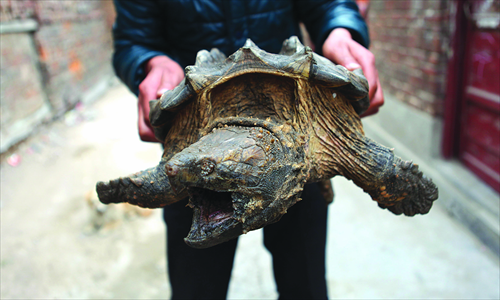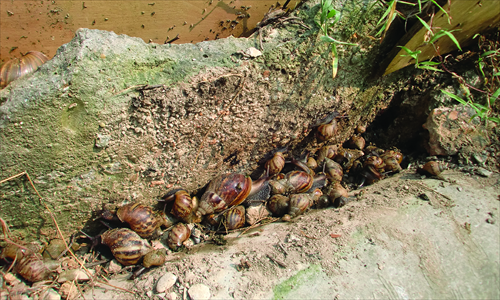Undesirable aliens

A snapping turtle, originated from the Americas, is discovered in the wilderness by a local resident in Tangyin, Henan Province, on April 1. Photo: CFP
Liu Yinghua had seen snails in the countryside before, when he was younger. But when he saw one the size of a fist crawling along a main road, it gave him a scare.
"I've never seen such a thing before," he said. "They started appearing at the beginning of last month, first in pairs, then all over the place when it started raining."
The highschool freshman in Nanning, Guangxi Zhuang Autonomous Region, saw the snails while visiting his grandparents in the town of Shajing at the edge of Nanning.
According to a report on gxnews.com, a teacher surnamed Liang from Shajing Middle School first found out about the snails, as they were hiding under some vegetables in her garden.
They were described as palm-sized and left eggs bigger than pomegranate seeds once the shells cracked.
Reports of invasive species have recently become alarmingly frequent in Chinese media. Snails, caterpillars, piranha, and species not native to China have been found in different parts of the country.
The second International Congress on Biological Invasions has just ended at the Qingdao Agricultural University on October 27. Scientists in attendance pointed out that 544 species were confirmed to have invaded China in the past 10 years.
Species from other lands
The snails were identified as Achatina Fulica, or giant African land snail, a species native to East Africa and a voracious feeder that can give birth to a large number of offspring. The species is also on the list of the 16 most invasive species, published jointly by the Chinese Academy of Sciences and the State Environmental Protection Administration in 2003.
The snails can eat the leaves of an entire vegetable garden overnight, experts said. They also carry many diseases and can spread tuberculosis.
Nobody knows how the snails suddenly swept into Nanning, Liu said. According to news reports, experts suspected the eggs were brought into Guangxi by some mode of transportation.
Beijing resident Ma Qian had a similar experience last month. When she went back to her hometown in Handan, Hebei Province during the National Day holidays, she was greeted by thousands of caterpillars. A photo she put up on her Weibo microblog showed that the caterpillars were gray, furry, and about 4-5 centimeters long.
"I was driven mad over the national holidays," she said. "One night, before I went to bed, my chest itched. I unzipped my shirt and found a caterpillar crawling there."
Her parents told her the city had seen a huge number of caterpillars this year. Some of her neighbors even swept up entire trash bags of caterpillar bodies in the morning.
Ma searched for photos online and found out the caterpillar was a fall webworm (Hyphantria Cunea), a species native to North America. It started coming to Hebei Province a couple of years ago, but it was the first time they had been seen in Handan on such a large scale.
The caterpillars have caused a great deal of damage, Ma said, eating all the leaves in the neighborhood trees.
"The bugs are found in a wide area, they can eat about 300 types of foods that include crops, woods or fruit trees, and they have a high reproduction rate," said Guo Shuxia, the office chief at the Handan Forestry Bureau Pest Prevention and Control Station in Hebei Province. She is also at a loss as to how the caterpillars got to Hebei.
"It's possible that they were brought over with cargo, but nobody knows for sure," she said.
According to a 2012 report in the Science and Technology Daily, the Ministry of Agriculture released statistics saying invasive species cause about 120 billion yuan ($19.7 billion) of damage every year to China. China also has more than 50 of the 100 species on the list of most destructive invasions published by the World Conservation Union.
While big snails and caterpillars may harm vegetation, other invasive species can even hurt people. A Shanghai-based translator, who wished to remain anonymous, said she had been bitten by a snapping turtle a couple of years ago on an organized trip to free captive animals.
"It has small teeth, but these turtles have strong jaws, so the impact was bigger. When I finally took my hand out, I saw two dots, not too big, but deep," she said.
It took her about two weeks to recover from the bite. When she looked it up online, she found many had the same experience as her.
Snapping turtles and Brazilian turtles were first brought to China as pets, but their invasive nature soon showed. Even though the species has become common in China, it doesn't diminish the fact they can be invasive.

Giant snails are found in Nanning, Guangxi Zhuang Autonomous Region. Photo: CFP
Dealing with the aftermath
Right now, most of the methods used to deal with such pests are still manual, said Xie Yongjun, the deputy secretary general of the Yueyang Cowfish Protection Association in Hunan Province.
Every year, the government in Hunan organizes people to remove the weeds that have taken over the surface of the Dongting Lake, such as alligator alternanthera, or water hyacinth. Such weeds grow rampantly over the lake and can endanger the fish that live there.
In early October, Xie participated in an event organized by the Hunan Department of Agriculture, in which the government, NGOs and volunteers took part to remove the weed from the lake.
"We took a shredding machine on the boat and cut apart the vines at first, then we pulled them up by hand. When the weed grows, the vines are all twisted together all over the lake. You can't cut them with scissors and need a shredding machine," Xie said.
After the weed has been fished out to shore, it's usually dried in the sun. Lime is added to it and it is then buried. During the event in October, all weeds were cleaned from a 2,700-meter long drainage canal.
The caterpillars were dealt with in the same way, Guo said.
It's not the first time caterpillars have appeared in Hebei Province, she said. In the last couple of years, these bugs have been found in all cities in Hebei Province except Zhangjiakou, and were found in Handan in 2009.
"These bugs don't have a natural enemy here, it's a new species. What we can do is control their population by hand," she said.
After the caterpillars were found, the local forestry bureau sent a team of specialists to spray pesticide over the treetops and set up nets under the trees to catch the caterpillars, Guo said. The measure did not eradicate the caterpillars, but it was the only available method.
"Every year when they come, we try to control it. Ever since 2009, we put in money and workers to try to control the pests. Right now they are only in roadside trees and fruit trees, not in crops," she said.
Once the pests settle in at a place, they can be quite hard to get rid of or control after a couple of years, Guo said. Right now, the government is trying to restrict the pests to a certain area and hope they won't cause too much damage.
In Guangxi, according to gxnews.com, experts recommend that the big snails be handled manually as well. Lu Shishen, an agronomist from the Agricultural Service Center in Jiangnan district of Nanning, advised collecting the snails while wearing sanitation gloves and destroying them with lime.
So far, it seems that humans haven't had much effect on the snails, Liu said. He suspected the snails have come out because it was the rainy season in September. In early October, after a week of dry weather, the snails disappeared from view. But they came again in late October after the rains came.
Human interference
Indeed, humans have had an impact on the environment and brought in the invasive species, said Xie Yan, a professor from the Chinese Academy of Sciences and founder of the China Species Information System.
"The snails were first brought in as a type of food. In Guangdong Province, adjacent to Guangxi, they eat snails and African land snails were brought in because of their size. When some were thrown away, they started growing in the natural habitat and causing problems," she said.
Starting in 2000, the Chinese government started investigating invasive species and a list was published in 2003 that included the African snail, alligator alternanthera and fall webworms.
"Once they invade, it's difficult to deal with them. We are basically at a loss as to what to do," she said.
Crawfish were also brought into China as food. But in April, crawfish destroyed many terraced rice fields in Yunnan Province.
Sometimes the method employed is a biological one, when the natural enemy of the species is imported. However, the enemy might end up causing an invasion as well, Xie said.
According to a 2010 report on Sanxiang Metropolitan News, the water hyacinth were brought to Dongting Lake to counteract the blue algae that had been growing there, but then started growing on the lake itself.
Other methods include using pesticides, but that might leave a residue and can run off onto nearby lands, causing more damage, Xie said. Right now, the safest method by far is to do it manually, but that takes money and time.
Establishing a unified law to keep away invasive species is an urgent task, Xie said.
"Every year, many foreign species are brought into China - flowers, seafood, animals as pets - and many are invasive. But we don't have a law to control it right now," she said. "Laws should be established for foreign animals and plants to go through inspection, and not just inspection for diseases, but for invasive risks as well."